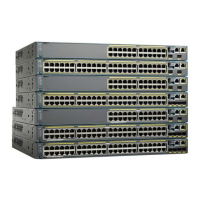VLAN). A reauthentication request allows the host to be placed in the appropriate authorization group when
its credentials are known.
To initiate session authentication, the AAA server sends a standard CoA-Request message which contains a
Cisco VSA in this form: Cisco:Avpair=“subscriber:command=reauthenticate” and one or more session
identification attributes.
The current session state determines the switch response to the message. If the session is currently authenticated
by IEEE 802.1x, the switch responds by sending an EAPoL (Extensible Authentication Protocol over Lan)
-RequestId message to the server.
If the session is currently authenticated by MAC authentication bypass (MAB), the switch sends an
access-request to the server, passing the same identity attributes used for the initial successful authentication.
If session authentication is in progress when the switch receives the command, the switch terminates the
process, and restarts the authentication sequence, starting with the method configured to be attempted first.
If the session is not yet authorized, or is authorized via guest VLAN, or critical VLAN, or similar policies,
the reauthentication message restarts the access control methods, beginning with the method configured to
be attempted first. The current authorization of the session is maintained until the reauthentication leads to a
different authorization result.
Session Reauthentication in a Switch Stack
When a switch stack receives a session reauthentication message:
•
It checkpoints the need for a re-authentication before returning an acknowledgment (ACK).
•
It initiates reauthentication for the appropriate session.
•
If authentication completes with either success or failure, the signal that triggered the reauthentication
is removed from the stack member.
•
If the stack master fails before authentication completes, reauthentication is initiated after stack master
switch-over based on the original command (which is subsequently removed).
•
If the stack master fails before sending an ACK, the new stack master treats the re-transmitted command
as a new command.
Session Termination
There are three types of CoA requests that can trigger session termination. A CoA Disconnect-Request
terminates the session, without disabling the host port. This command causes re-initialization of the authenticator
state machine for the specified host, but does not restrict that host’s access to the network.
To restrict a host’s access to the network, use a CoA Request with the
Cisco:Avpair="subscriber:command=disable-host-port" VSA. This command is useful when a host is known
to be causing problems on the network, and you need to immediately block network access for the host. When
you want to restore network access on the port, re-enable it using a non-RADIUS mechanism.
When a device with no supplicant, such as a printer, needs to acquire a new IP address (for example, after a
VLAN change), terminate the session on the host port with port-bounce (temporarily disable and then re-enable
the port).
Catalyst 2960-XR Switch Security Configuration Guide, Cisco IOS Release 15.0(2)EX1
OL-29434-01 59
Configuring RADIUS
RADIUS Change of Authorization
